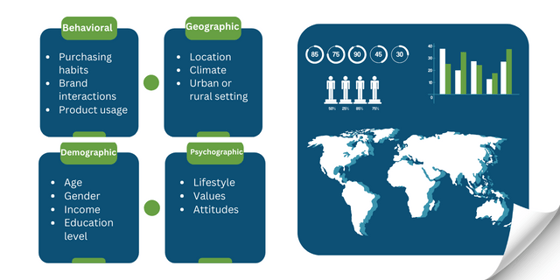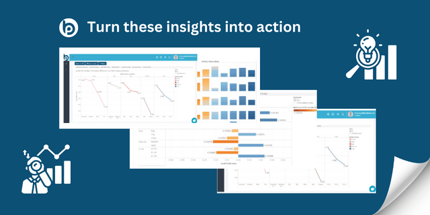Customer Segmentation: Exploring Effective Practices for Segmenting Your Customers
 PriceBeam
·
4 minute read
PriceBeam
·
4 minute read
Introduction
In today’s fast-paced market, knowing your customer is not just an advantage, it’s a necessity. That’s where customer segmentation comes into play. Why is this segmentation a game-changer? Imagine being able to predict what your customers want before they even ask for it. By grouping them based on shared characteristics, be it age, location, buying behavior, or preferences, you can anticipate their needs, tailor your offerings, and communicate in a language that speaks directly to them.
In a world where customers are bombarded with information, making your message stand out is crucial. Customer segmentation allows you to cut through the noise, delivering targeted messages that capture attention and inspire action. It’s about being relevant to your customers.
Understanding Customer Segmentation
Imagine a scenario where you could instantly categorize people based on what they value most. This is essentially customer segmentation in the business landscape. It involves organizing your customers into groups that share similar traits, enabling you to customize your marketing efforts to meet the unique preferences, needs, and desires of each group.
Recognizing the critical role of customer segmentation, it's worth reflecting on its influence on your marketing approach. The reality is that not everyone will be swayed by the same communication or proposition. By identifying and understanding these distinct groups, you can craft messages that resonate deeply with each segment’s interests, making your marketing more impactful.
Bases for Segmenting Customers
There are several ways to slice the pie (or segment your customers):
- Demographic: Who your customers are; age, gender, income level, etc. It’s like sorting books by genre.
- Psychographic: Your customers' lifestyles, values, and beliefs. It’s like choosing a book based on your mood.
- Behavioral: How customers interact with your brand, how often they purchase, what they buy, and their overall engagement. It’s like tracking which books are most popular in the library.
- Geographic: Where your customers are located. Marketing a snow shovel in Florida? Probably not a great idea. Geography matters.

Leveraging Technology in Customer Segmentation
Remember the old days of manually sorting through customer feedback forms? Neither do we, thanks to technology. Data analytics and AI have not just entered the game; they're changing the rules. They sift through mountains of data to find the gold nuggets of insight that drive smarter, more effective customer segmentation. With these tools, predicting customer behavior isn't just possible, it's precise.
Tools and Software for Enhanced Segmentation
Imagine having a master key, but for customer data. Modern technology provides powerful tools for customer segmentation, for instance CRM (Customer Relationship Management) systems serve as a comprehensive repository, maintaining detailed records of every customer interaction. Also, analytics platforms play a crucial role in deciphering behavior patterns and preferences, offering valuable insights. Additionally, AI-driven tools are equipped to predict future trends by meticulously analyzing current data.
Enter PriceBeam, which turns these insights into action.
By delving into the depths of market perception, PriceBeam's market research studies offer a unique lens through which businesses can transform their pricing strategy. It's like having a direct line to what your customers are thinking and feeling about your prices, empowering you to make adjustments that resonate with them. This isn't just data analysis; it's a strategic advantage in the highly competitive marketplace.
Using one of our most popular studies as an example, the comparative willingness-to-pay study, unveils a powerful connection to customer segmentation.
The results of this study would act as a detailed guide to uncovering precisely what different segments of your customer base are prepared to pay for your offerings within any specific market. This technique is about gathering and analyzing data to reveal the distinct price preferences of each customer segment. This facilitates a direct comparison of this insight, shedding light on the unique willingness to pay across various demographics, psychographics, or behavioral groups.
In essence, this analysis strengthens the bond between pricing strategy and customer segmentation. It offers you a strategy not just for making informed pricing decisions but for forging deeper connections with each segment of your market.

By leveraging this analysis, studies such as this one can provide more than data; They deliver a strategic pathway to engaging distinct customer segments through thoughtful and competitive pricing.
Common Challenges in Customer Segmentation
Dealing with customer segmentation comes with its own set of challenges. Firstly, getting and making sense of customer data isn't always straightforward. This data is key for dividing customers into groups that make sense for your business. Then, there's the fact that what customers want and how they act, can change pretty quickly.
Businesses need to keep their segmentation up to date to match these changes. Also, when it's time to use these customer groups in your marketing, making sure you're consistent across all the different ways you talk to your customers - like on social media, email, or your website - can be tricky.
All these points highlight why it's so important to stay flexible and understand your customer data. This way, you can keep up with your customers' changing needs and make sure your business stays ahead.
Solutions and Recommendations:
- Stay organized: Keeping your database neat and up-to-date is crucial. It makes sure your efforts to group customers are based on reliable and accurate information.
- Use the right tools: For effective customer segmentation, using the right technology is essential. Tools like Market Research Insights help you test and refine your pricing strategies even as the market changes, giving you a clear view of what works.
- Be flexible: As the market changes, being ready to update your customer segmentation strategies helps you keep meeting your customers' needs effectively.
Conclusion
Effective customer segmentation is like having a conversation where you’re genuinely interested in the other person, it makes all the difference. By understanding your customer groups' distinct needs and desires, you can tailor your approach to meeting them where they are, with what they need. Technology, especially AI and data analytics, is your ally in this journey, helping you to navigate through the complexities of modern markets. As we wrap up, remember that our platform tools can transform your approach to customer segmentation, making your marketing efforts more precise and impactful.
Want to see how our studies can directly benefit your business?
.png?width=400&height=100&name=PBLogoTransparent%20(1).png)




